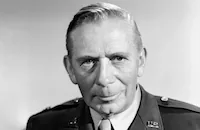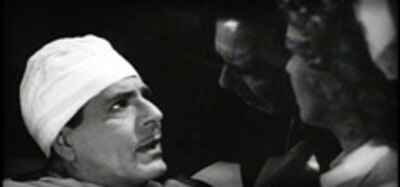Crime Doctor

Brief Synopsis
Cast & Crew
Michael Gordon
Warner Baxter
Margaret Lindsay
John Litel
Ray Collins
Harold Huber
Film Details
Technical Specs

Synopsis
A man, who has been thrown from a speeding car, is found unconscious alongside Queens Road and is taken to a sanitarium by some passing college students. The nurses dub their unconscious patient "Ordway" because he is residing in a room endowed by the late philanthropist Robert Ordway. Consequently, when the man regains consciousness and discovers that he is suffering from amnesia, he takes the name of Robert Ordway. One day, while the recuperating Ordway is sitting in the hospital's solarium, a man approaches, calls him Phil and demands to know the location of "the valise." The man runs away when Ordway denies any knowledge of a valise and buzzes for help. Soon after, Ordway is released from the hospital and accepts the invitation of his physician, John Carey, to live at the doctor's house. When all avenues are exhausted and even his fingerprints yield no information about his identity, Ordway begins to indulge in self-pity. Tiring of his patient's self-destructive behavior, Dr. Carey challenges him to begin a new life, so Ordway decides to learn medicine and cure himself. Ten years later, Ordway has attained a degree in psychiatry and is in practice with Dr. Carey. Sensing he has an affinity for criminals, Ordway has devoted part of his practice to working within the prison system. When social worker Grace Fielding brings a prisoner to Ordway's office one day, the doctor and social worker become romantically involved. While at a nightclub with Grace, Ordway is recognized as gangster Phil Morgan by Joe Dylan and Nick Ferris, two members of Morgan's gang. Shocked, Nick accidentally cuts his hand and is treated by Ordway. When Nick mentions that the doctor reminds him of Morgan, Ordway eagerly begins to question him, and Nick gives him a fake name and address. Outside the club, Nick and Joe are greeted by Emilio Caspari, another member of the gang, who has just been released from prison after serving a ten- year sentence. Emilio, who had visited Ordway at the sanitarium ten years earlier, is convinced that the doctor is Morgan and has been following him, hoping that he will lead him to a valise containing $200,000, which was stolen in a robbery. While visiting the prison one day, Ordway witnesses William Wheeler, an inmate and former military officer, trying to escape. Although he is warned by the warden that Wheeler is incorrigible, Ordway insists on interviewing the prisoner. In their meeting, Ordway convinces Wheeler that his leadership abilities can be positively employed to train his fellow prisoners. When Ordway's experiment proves a success, Wheeler is granted a parole and the doctor is appointed to head the parole board. Ordway's acceptance speech is broadcast throughout the state prison system. In the women's penitentiary, inmate Pearl Adams listens to the speech and recognizes Ordway's voice as that of Phil Morgan, her old boyfriend. Soon after, Emilio visits Ordway at his office and questions him about the missing $200,000. After Emilio leaves the office, Grace follows him to Frankie's Bar and threatens to have him arrested if he continues to harass the doctor. Uncertain whether Ordway is lying about his amnesia, Emilio decides to enlist Pearl's help in exposing the doctor. Following Emilio's suggestion, Pearl petitions for parole and at her hearing, she accuses Ordway of being Morgan. Stunned by her accusation, Ordway decides that the only way to regain his memory is to reenact the circumstances surrounding the robbery and decides that he must contact the gang. Directed by Grace to Frankie's Bar, Ordway finds Joe, Emilio and Nick there and asks their help in reconstructing the events that led up to Queens Road. The three then take Ordway to the room they fled to after the robbery. When Emilio accuses Ordway of cheating them and admits to throwing him unconscious from the car, the two men begin to fight and Ordway is struck on the head. His memory restored by the blow, Ordway seizes a gun, takes the gangsters prisoner and calls the police to return the money. Brought to trial for robbery, Ordway argues that his body houses two identities, that of the criminal Phil Morgan and of the innocent psychiatrist Robert Ordway. When the jury returns a guilty verdict with a recommendation for clemency, the judge suspends the doctor's sentence, allowing him to leave the courtroom as Robert Ordway.

Director
Michael Gordon
Cast

Warner Baxter

Margaret Lindsay

John Litel

Ray Collins

Harold Huber

Don Costello

Leon Ames
Constance Worth

Dorothy Tree
Vi Athens
Craig Woods
Al Shean
Crew

Videos
Movie Clip


Film Details
Technical Specs

Articles
Crime Doctor
This first picture in the series shows how Ordway becomes the "crime doctor." He's a ruthless criminal himself, leading a gang of bad guys who double-cross him and leave him for dead, not knowing that he had already double-crossed them out of their stolen money. Awakening in a hospital with no memory, he starts his life anew, learning medicine over the years and ultimately becoming a criminal psychologist. It's only a matter of time, however, before his old gang finds him again...
Crime Doctor was a success. "A tightly-knit and interestingly-told drama that will provide good program support in the regular runs," declared Variety. "In the nabe and outlying bookings, marquee voltage of Warner Baxter can generate some extra customers."
The New York Times mused, "How many tales have been woven from this amnesia fabric, heaven only knows. Yet the well probably never will go dry. The subject carries an elementary suspense, and because of this the newcomer manages to turn out a fair piece of melodrama."
The reviewer added that all the major cast members "handle their roles with finesse," and indeed, the supporting players are an enjoyable bunch: Margaret Lindsay, John Litel, Leon Ames, and Ray Collins, who originated Robert Ordway on the radio show and here has a small role.
Crime Doctor's director, Michael Gordon, came to Hollywood in 1940 from a career in the New York stage world. He's best known for Cyrano de Bergerac (1950) and Pillow Talk (1959), though for most of the 1950s he was blacklisted for his leftist personal politics. Crime Doctor was one of his earliest credits. Interviewed for Ronald L. Davis's book Just Making Movies, Gordon said he started at Columbia Pictures as a dialogue director ("the lowest position on the totem pole") and then assistant director. "I saw working there as a job of transition," he recalled. "I knew damn well by then that I was going to be a director. I had the snobbish attitude toward Hollywood that most people from Broadway had. But I did recognize that the screen could be an effective medium and had many more resources in terms of story telling than the stage offered... I said to myself, 'This is going to be a learning experience.' The things I needed to learn really broke down into three categories - the camera , the soundtrack, and the cutting room...."
On his first movie as director, Boston Blackie Goes Hollywood (1942), Gordon fell half a day behind schedule and was called into Irving Briskin's office. Briskin, the head of Columbia's B unit, explained that a good B picture probably wouldn't gross much more than a bad B picture; therefore, he said, "I don't want it good. I want it Thursday!"
Gordon directed three more B's, on 10- or 12-day schedules, and was paid "below scale, $125 a week. Even my assistant director was making more than I did. In my third year at the studio I was placed on lay-off. I'd directed these four pictures, the last of which was Crime Doctor, and thought I was ready for something better. I was told that the studio only had good pictures coming up. I said, 'Well, I'm ready for a good picture.' The answer I got from Irving Briskin was: 'How can we give you a good picture? Look at the money you make.' In other words, somebody who was making $125 a week couldn't direct a good picture. That's when I walked out on my contract and was threatened with never being able to work in Hollywood again. I went back to New York and soon got Home of the Brave to direct on Broadway. Three years later I was back in Hollywood at ten times the salary I had been making."
Warner Baxter was in poor health in the 1940s, having suffered a nervous breakdown and arthritis among other ailments; the Crime Doctor films were mercifully easy assignments for him physically. He died of pneumonia in 1951, two years after his final appearance as Dr. Ordway.
Producer: Ralph Cohn
Director: Michael Gordon
Screenplay: Graham Baker, Louis Lantz; Max Marcin (radio series); Jerome Odlum (adaptation)
Cinematography: James S. Brown, Jr.
Music: Lee Zahler, Mischa Bakaleinikoff (uncredited)
Film Editing: Dwight Caldwell
Cast: Warner Baxter (Dr. Robert Ordway), Margaret Lindsay (Grace Fielding), John Litel (Emilio Caspari), Ray Collins (Dr. John Carey), Harold Huber (Joe Dylan), Don Costello (Nick Ferris)
BW-67m.
by Jeremy Arnold

Crime Doctor
Quotes
Trivia
Notes
Although the character played by John Litel is named "Three Fingers" in the Variety review, in the film he is called "Emilio Caspari." This was the first picture in Columbia's "Crime Doctor" series, which was based on the CBS radio program of the same name. The radio show was broadcast from 1940-1947, and over the years, Ray Collins, House Jameson, Everett Sloane and John McIntire portrayed Robert Ordway, the "Crime Doctor." The Columbia series ran from 1943-1949 and consisted of ten films, all starring Warner Baxter as Ordway. Rudolph Flothow was the producer of all but the first film, which were produced by Darmour, Inc. for Columbia.














